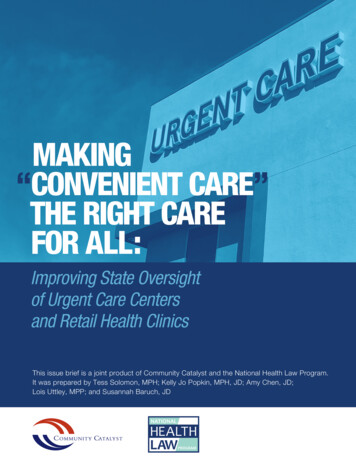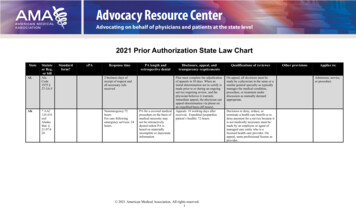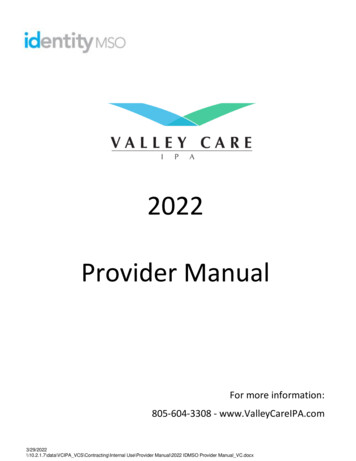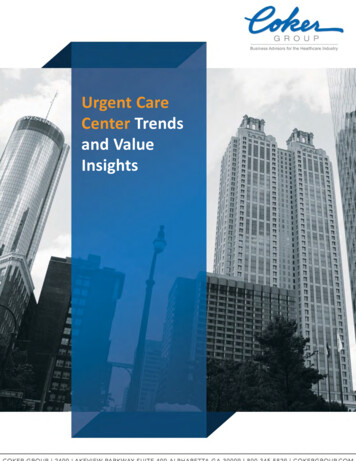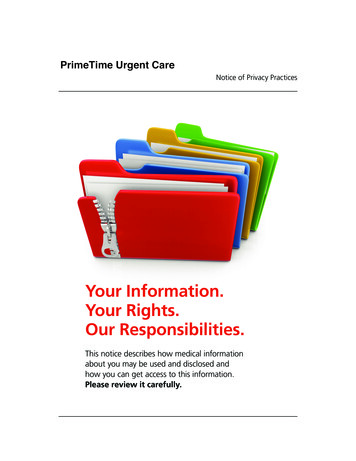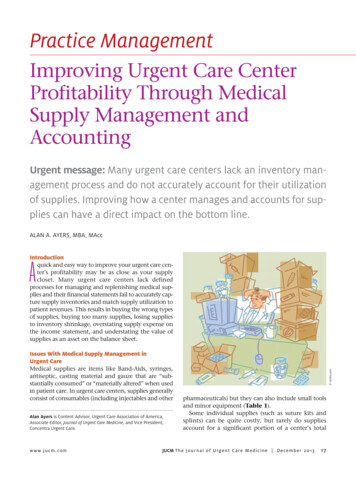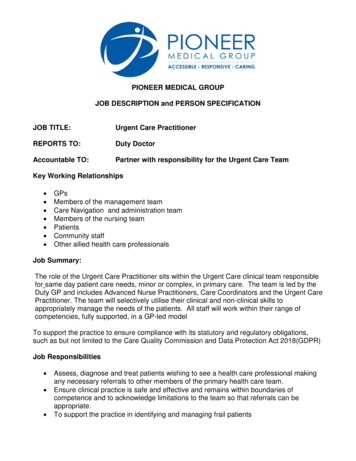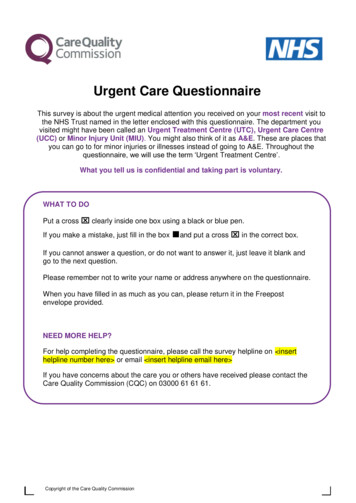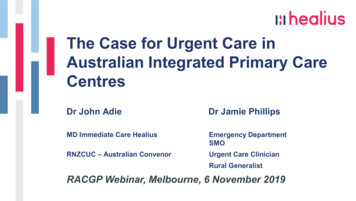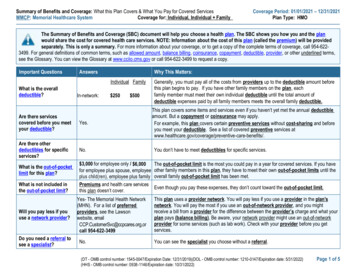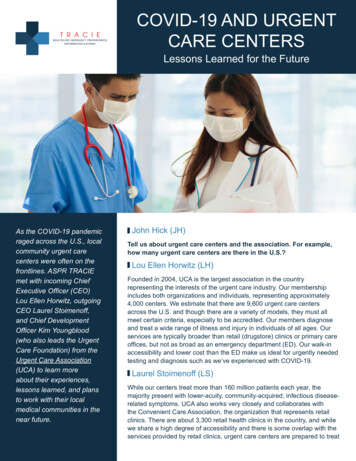
Transcription
COVID-19 AND URGENTCARE CENTERSLessons Learned for the FutureAs the COVID-19 pandemicraged across the U.S., localcommunity urgent carecenters were often on thefrontlines. ASPR TRACIEmet with incoming ChiefExecutive Officer (CEO)Lou Ellen Horwitz, outgoingCEO Laurel Stoimenoff,and Chief DevelopmentOfficer Kim Youngblood(who also leads the UrgentCare Foundation) from theUrgent Care Association(UCA) to learn moreabout their experiences,lessons learned, and plansto work with their localmedical communities in thenear future.John Hick (JH)Tell us about urgent care centers and the association. For example,how many urgent care centers are there in the U.S.?Lou Ellen Horwitz (LH)Founded in 2004, UCA is the largest association in the countryrepresenting the interests of the urgent care industry. Our membershipincludes both organizations and individuals, representing approximately4,000 centers. We estimate that there are 9,600 urgent care centersacross the U.S. and though there are a variety of models, they must allmeet certain criteria, especially to be accredited. Our members diagnoseand treat a wide range of illness and injury in individuals of all ages. Ourservices are typically broader than retail (drugstore) clinics or primary careoffices, but not as broad as an emergency department (ED). Our walk-inaccessibility and lower cost than the ED make us ideal for urgently neededtesting and diagnosis such as we’ve experienced with COVID-19.Laurel Stoimenoff (LS)While our centers treat more than 160 million patients each year, themajority present with lower-acuity, community-acquired, infectious diseaserelated symptoms. UCA also works very closely and collaborates withthe Convenient Care Association, the organization that represents retailclinics. There are about 3,300 retail health clinics in the country, and whilewe share a high degree of accessibility and there is some overlap with theservices provided by retail clinics, urgent care centers are prepared to treat
higher-level acuity patients because of on-site lab and x-ray capabilities.Our centers are located in every area of the country from large urban areasto rural communities where they are often the sole primary care providers.Kim Youngblood (KY)The Urgent Care Foundation (UCF) is an affiliate of the Urgent CareAssociation and its mission is to serve the urgent care industry in the areasof research, education, clinical and practice management leadership,as well as innovation in new and emerging healthcare delivery models.The Foundation is very interested in partnering with ASPR TRACIE sinceemergency preparedness is of critical importance to our members andthe industry. In fact, we initially launched an Emergency PreparednessInitiative to assist our members with Hurricane Harvey relief efforts andover the past several years, we have expanded our work in this area byleading initiatives to fund education and training for clinicians including ourmost recent efforts to support the urgent care industry with our COVID-19Emergency Fund.JHHow have things shifted since the 2009 H1N1 pandemic?LHThe main lesson learned from H1N1 was that we had not set up adequateconnections between state-based resources and urgent care centers. Atthat time, our industry was still relatively new and more fragmented and wedid not have the bandwidth to conduct more expansive outreach. That haschanged over the past decade and now urgent care centers are locatedin every area of the country and our efforts are more coordinated. UCAhas mapped urgent care centers and they can be easily located by visitingour website. We’ve also had time to build relationships, such as the onewith ASPR TRACIE. While we definitely learned some valuable lessonson emergency preparedness after the H1N1 pandemic, I think we all fellinto the trap of getting busy with our next initiatives and neglecting to reallysolidify the connective pathways so we could be better prepared for thenext emergency. In fact, last year I presented on an ASPR TRACIE panel,and while our industry has matured, and our numbers grown significantly,we still had members in the audience unaware of the availability andaccessibility of urgent care. We have more work to do so our fellowhealthcare leaders fully understand our capabilities. They do not haveto recreate the wheel in a pandemic situation like COVID-19 as we havealready built it and are ready to roll.JHWhat are the key issues facing urgent care centers amid COVID-19?LSThe COVID-19 pandemic has changed our industry. As an organization,UCA had to quickly respond and address the needs of our members.Some of the first positive COVID-19 patients presented at several urgentcare centers in New York City. While most centers have emergencyresponse plans as a result of previous pandemics such as seasonal
COVID-19 willforever changehow we respondto pandemics, andwe will emergefrom this crisis asa better industryand organization,forward thinkingand proactive.- Laurel Stoimenoffinfluenza, HIV, and H1N1, the U.S. healthcare community, like most of theworld, was not prepared for COVID-19. As a result, UCA redirected itsactivities and dedicated one of our listservs solely to COVID-19 to providea forum for the exchange of clinical and operational information regardingpreparedness and testing. For the most part, discussions focused onthe clinical side. Our members were thankful for this platform, since thepandemic created unique new challenges around testing, PPE shortages,patient safety, and protecting staff from a novel infectious disease all whilemanaging the drop off in patient volume and furloughing employees.Another challenge our members faced was being able to messagecommunities and the field at large about their capabilities. We remainrelatively fragmented, and while centers were perfectly capable of runningthe testing process, for example, they were not always seen as an optionbecause many planners do not understand the varied scopes of practice.This led to the creation of a COVID-19 centralized database to ensure thatpatients and the public health community understood our full capacity toprovide testing. We have canvassed our members to note specific testingcapabilities (e.g., PCR or antibody testing for COVID-19). We created thisdatabase in direct response to media and state departments of healthinquiries regarding center capabilities. This will also allow us to quicklyassess the number of urgent care centers that are equipped to provideCOVID-19 vaccines when they are available.JHEarly on, we were prohibited from taking COVID-19 test samplesunless we were in an airborne isolation room, which most urgentcare centers do not have. Then, that guidance was modified. As thelandscape shifts, and guidance is modified, how do you adjust tothese changes?LHWe can move quickly, make changes, and adapt to different situations inurgent care. Walk-in medicine teaches you to embrace change on day one.We are an industry that is both proactive and consumer responsive, so asCOVID-19 evolves, so will our members.LSIn the beginning of the pandemic when guidance was very limited, one ofour most respected clinicians noted on the listserv that “urgent carecenters are not the appropriate sites for testing. We don’t have enoughpersonal protective equipment (PPE), and we should be making referrals.”To which many members replied, indicating that they are the only sourcesof medical care in their areas and we needed to figure out how to providetesting. So, they went to work to develop protocols and source the neededsupplies. We’ve surveyed our members every two weeks, and at first, only30-40% were able to test for COVID-19 (many did not have access to PPEor testing kits). Now, 90% of our members have a mechanism forconducting some form of COVID-19 testing (PCR and/ or antibody). Thetime to get a test result has shortened as well.
JHTell us more about PPE challenges, from a programmatic andsupply perspective.LSHistorically, patients with infectious diseases (e.g., measles and influenza)visit urgent care centers to receive a diagnosis and treatment; urgentcare centers are currently testing a disproportionate share of COVID-19patients. From an accreditation perspective, we ensure members haveprocedures in place if there is some type of exposure, but for the mostpart, we do not have the in-room ventilation capabilities. There are someexceptions, such as those clinics created by converting an old ED. Ourmembers were desperate for PPE in the beginning. About 10% of theindustry was responding to our weekly surveys that they could not getbasic surgical masks or gowns, and N95 masks were almost impossibleto find. It has been a challenge to the entire health care industry andinexplicably urgent care centers are often very far down the PPEdistribution list. In Pennsylvania, for example, urgent care centers weredown in group 3, despite being on the front line of the pandemic. EDs werein group 1.JHWhat proportion of centers routinely used N95 prior to COVID-19?What other types of PPE are used?LHI came from a large health system with over 40 urgent care centers, andwe didn’t use them routinely in any of our centers, so it is very uncommon.When the COVID-specific guidance about masks initially came out, therewas an enormous reaction and rush to get them, but within a coupleof weeks, that guidance changed, too. I would assume most urgentcares have gone back to their regular level of PPE and are using moreface shields than used to be routine. Workflow changes that conservedPPE and kept people from coming in before being screened have alsobeen implemented. Use of telemedicine has also helped with that inmany centers.JHHow has provision of care changed since COVID-19, especiallyregarding screening?LSThere are quite a few best practices emerging now; some screen patientsin parking lots, others post messaging on their websites, instructingpatients to call ahead if they have any symptoms. Other practices includebringing suspected patients in through the back door, separating sickfrom well patients in reception, and isolating rooms for two hours if asuspected case was treated within. We worked with the American Collegeof Emergency Physicians to develop risk stratification and decide whento send a patient to the emergency department. We are currently working
on pediatric risk stratification data. Many centers are using an app thatencourages patients to “check in” online, and report to the center at aspecific time. We found it was critical to ensure that staff and consumersknew urgent care centers were a safe environment to work in and visit.LHIt is important for the community to understand all the steps we havetaken to keep them safe in our centers; we reassure them that it is stillimportant to seek needed medical care. We know the entire field is facingthis challenge.LSThe Centers for Disease Control and Prevention recently conducted astudy in Michigan, finding that vaccination rates for “traditional” diseasesin children and adults have decreased 50% percent. That really resonatedwith me. It is interesting in part because commercial payers exclude urgentcare centers from being able to do perform wellness activities includingvaccinating people. When we conduct our annual benchmarking survey,we find that between 20 and 40% of consumers presenting at urgent carecenters do not have primary care physicians, so it makes no sense thatwe cannot provide them with these services. We are trying to get the wordout to the field at large; we should be able to administer an immunizationand conduct a physical in addition to providing medical care for illnesses orinjuries which require prompt attention.JHWhat areas of education and training have you devoted the mosttime and effort to and what do you see going into the fall as thebiggest need?LSWe have done both clinical and operational types of training. We had aclinical town hall for our members where we summarized listserv activityand had clinicians serve as panelists. Operationally, we shared strategiesfor recovering from the lost business, ensuring a safe environment of careand applying for the paycheck protection program and other ways theCARES Act can help centers remain open. We have also looked at thefuture; in Arizona, a firm conducted a consumer survey to determine topconcerns. Reopening was one of their top concerns; they were afraid ofsitting in the same room with someone who may be infectious, even if bothpeople were wearing masks. It is important to visually demonstrate that inthe centers and communicate it on their website, in person so the patientfeels safe returning for a face to face meetings. The next clinical townhall will focus on fall surge—how to prepare for the dual impact of flu andCOVID-19 patients.LHA lot of our work is done in collaboration with the College of Urgent CareMedicine (CUCM). Many centers already had some aspect of integratedtelemedicine that they were able to set up very quickly. Major industryplayers on the electronic medical records side and patient queuing sides
were very quick to support us. Innovation in testing capabilities as weface a combined influenza/COVID-19 season is top of mind, and improvedcollaboration with the payer community in covering the costs of the newdiagnostics (and ultimately vaccines) is critical.JHWhat are the key concerns of providers? Are you seeing issueswith staffing?LHOne of the major challenges has been keeping up with the ever-changingguidance as it applies to staff and other resources. It’s difficult to strikea balance between not having enough PPE and being unable to seepatients, furloughing staff until suppliers can ensure there is enough PPEto ensure patient and provider safety. As we addressed those challenges,and the guidance was still being clarified, our centers wanted to be able tojump back in to providing care as soon as possible. It is extremely difficultto know how long to close centers or furlough staff; they must be able toquickly ramp back up when they can. While there were excellent intentionsand benefits behind increasing unemployment benefits, the temporaryincrease made it almost too attractive financially to be on unemployment.From a clinical perspective, the main challenge is that we do not fullyunderstand this virus yet. This makes managing patients and knowing theappropriate level of PPE to provide challenging. We are treating everysingle patient as a potential positive. Getting back to “normal” operationsis hard to envision. It is hard to know what “adequately protected” means,even when employers are going above and beyond what has beenindicated. With the variance in symptoms, this has also required us to do adeeper dive into patient history (e.g., comorbidities) than we would typicallydo with a sprained ankle, for example, because that patient could also bean asymptomatic positive COVID-19 patient.JHWhat do we need to do to get this right in fall and winter seasons?LHWe still need to increase the state-based awareness of urgent care asan existing and viable opportunity for diagnosis and treatment. In Seattle,for example, they were using public funding and a football stadium to testand treat COVID-19 patients when there is ample capacity in urgent carecenters in the city to assist. It’s just a lack of awareness and connectionthat must be improved. To that end, we are connecting with DOH leadersacross the country to provide our database of centers that are testing.Our CUCM partners are leading discussions about what a flu/COVIDseasons looks like from a clinical guidance standpoint. The flu guidancehas traditionally been to treat for flu if a patient has symptoms versuswaiting for test results. Now, should we test for flu and the COVID-19 virusboth on all upper respiratory patients? A clear clinical approach coupledwith collaborative patient direction is the key.
LSI recently asked someone whose role is to monitor this type of data if theyhave seen a lot of urgent care centers closures. Many have weatheredthe storm because they had some telemedicine opportunities to care forpatients. There was parity in payment that also helped. They are good attalking to patients and asking the right questions. That said, when and howwe determine when patients should come in (and how do we educate andencourage patients to come in) to the center is equally important. Thoseare the algorithms we should be looking at now.KYUCA and the Foundation are also hosting a Clinical Consortium at theend of July to strategize on industry preparedness for the upcomingconvergence of COVID-19 and the fall flu season. We’re convening 40-50CEOs and CMOs from the top urgent care centers, public health officialsfrom across the country including from the CDC, to provide direction toour members for anticipated fall resurgence. We’re going to curate all ofthe best practices, “lessons learned” and the latest resources with COVID,so our members can be fully prepared to provide the best possible patientcare.
how many urgent care centers are there in the U.S.? Lou Ellen Horwitz (LH) Founded in 2004, UCA is the largest association in the country representing the interests of the urgent care industry. Our membership . includes both organizations and individuals, representing approximately 4,000 centers. We estimate that there are 9,600 urgent care centers
